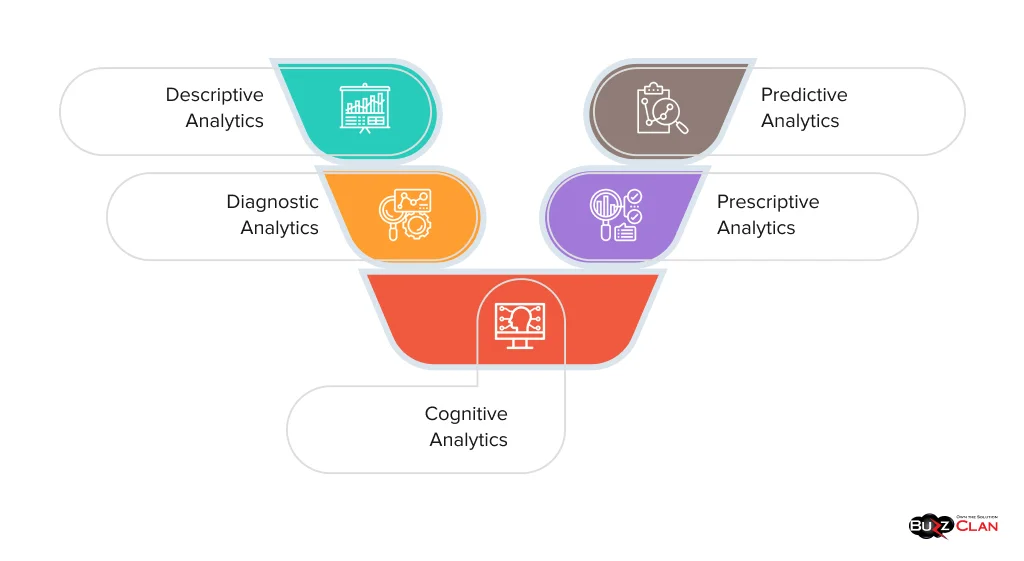What Are the 5 Types of Data Analytics and Which One Fits Your Use Case?
Rahul Rastogi
Jul 23, 2025
You’ve invested in data platforms. Your teams are building dashboards.
But decisions still stall. Insights come too late. And strategy often feels like guesswork dressed in charts.
Sound familiar?
The truth is, most businesses don’t have a data shortage; they have an analytics mismatch.
They’re using descriptive analytics when they need predictive foresight, or relying on diagnostics when automation is the real opportunity.
To make data truly work for your business, you need better alignment: the right type of analytics applied to the right use case.
In this blog, we’ll break down the 5 types of data analytics and how to choose the one that solves your business challenge.
What is Data Analytics?
At its core, data analytics is the discipline of examining raw data to uncover patterns, trends, preferences, and insights that inform decisions. But for today’s business leaders, it’s not just about generating reports—it’s about enabling agility, accuracy, and competitive advantage at every level. This starts with understanding the nature, volume, and velocity of your data—what we call Big Data.
In modern enterprises, data analytics plays a far more strategic role than it once did. It powers everything from real-time supply chain decisions to predictive customer engagement and automated risk detection.
The true value of data analytics lies not in the numbers but in the quality of decisions it enables.
That’s why understanding the different types of analytics and when to use them is critical for effective decision-making.
The 5 Types of Data Analytics and Why They Matter
The type of analytics you choose directly impacts the quality of your business decisions. Each type plays a distinct role in solving different challenges, from understanding what happened to determining what actions to take next.
Let’s explore the top five types of data analytics—and how to use each one for your specific business use case.

Descriptive Analytics
Descriptive analytics is the foundation of data-driven decision-making. It involves analyzing historical data to identify trends, patterns, and outcomes that have already occurred.
This type of analytics summarizes large volumes of data into clear, structured formats such as reports, dashboards, and scorecards.
While descriptive analytics doesn’t offer insight into causes or predictions, it delivers clarity. For business and technology leaders, descriptive analytics provides a clear, objective view of how the organization is performing.
It helps companies understand things like:
- How much did we sell as a company this month?
- What was our overall productivity across teams?
- How many customers churned in the last quarter?
It highlights what’s on track, what’s underperforming, and where key shifts are occurring. This visibility is critical for aligning teams, identifying areas that need attention, and establishing a performance baseline before moving toward more advanced analytics or transformation initiatives.
Where It Fits in Business Decision-Making
Descriptive analytics is essential for:
- Operational Oversight: Track performance metrics in real-time and over time.
- Executive Reporting: Standardize KPI communication across business units and stakeholders.
- Baseline Setting: Use past data to benchmark progress before introducing change or automation.
Example Use Case
A Chief Operating Officer monitors order fulfillment rates across regions through weekly dashboards. These descriptive insights help identify geographic bottlenecks and inform operational reviews, but they don’t explain why delays are happening or what to adjust. For that, the team would layer in diagnostic analytics.
Diagnostic Analytics
Diagnostic analytics helps organizations move beyond surface-level reporting by identifying the reasons behind trends, anomalies, and performance shifts. While descriptive analytics shows what happened, diagnostic analytics uncovers the “why”. This makes it a critical tool for root cause analysis and informed problem-solving.
This type of analytics uses techniques like data drill-downs, correlations, and comparative analysis to pinpoint contributing factors and uncover hidden patterns within the data.
It helps companies understand things like:
- Why did customer churn increase in one region but not in others?
- What caused a sudden drop in sales from a previously high-performing product line?
- What’s stopping leads from closing?
For business and technology leaders, diagnostic analytics enables more confident and timely decisions by providing context and causality. Instead of acting on assumptions, teams can intervene with targeted strategies backed by data-driven insight.
Where It Fits in Business Decision-Making
Diagnostic analytics is essential for:
- Performance Troubleshooting: Understand deviations in KPIs and isolate the root causes.
- Customer Behavior Analysis: Identify factors contributing to churn, drop-offs, or engagement dips.
- Operational Optimization: Pinpoint inefficiencies or process breakdowns across departments.
Example Use Case
A VP of Marketing sees a decline in qualified leads from digital channels. Descriptive dashboards confirm the drop, but diagnostic analytics reveal that recent changes to targeting parameters reduced campaign visibility for key customer segments. With this insight, the team adjusts targeting and restores lead quality, avoiding wasted spend and pipeline disruption.
As your organization moves from reporting to root cause analysis, it’s common to explore deeper capabilities like modeling, prediction, and automation. That’s where the line between data analytics and data science starts to blur.
Learn how data analytics differs from data science and when you need each.
Predictive Analytics
Predictive analytics focuses on forecasting future outcomes based on historical data, patterns, and statistical models. It uses techniques such as regression analysis, time series forecasting, and machine learning to project what’s likely to happen under given conditions.
It helps businesses shift from reactive to proactive decision-making, anticipating trends, risks, or opportunities before they materialize. This enables leaders to allocate resources more effectively and respond to market shifts with greater confidence.
It helps companies answer questions like:
- What’s the optimal price point to maximize profit without losing demand?
- How should we adjust inventory to meet projected demand while reducing excess?
- Which customers should receive a specific offer or promotion to increase retention?
For business leaders, predictive analytics brings clarity to uncertainty. It enables smarter forecasting across sales, marketing, finance, and operations—so teams can act on insights, not instinct.
Where It Fits in Business Decision-Making
Predictive analytics is essential for:
- Sales and Revenue Forecasting: Anticipate future performance based on current trends.
- Risk Mitigation: Identify and address issues before they escalate.
- Customer Intelligence: Target outreach to high-potential segments with precision.
Example Use Case
A Chief Marketing Officer at a B2C company uses predictive analytics to identify customers most likely to convert during an upcoming promotion. Based on historical campaign data and behavioral patterns, the model scores leads in real time. This enables the team to prioritize high-value prospects, resulting in improved conversion rates and higher campaign ROI.
Prescriptive Analytics
Prescriptive analytics goes a step beyond prediction. It focuses on recommending the best course of action based on data-driven insights. It uses optimization, simulation, and decision models to answer: What should we do next?
This is one of the most advanced types of data analytics. It transforms predictive outputs into actionable strategies, allowing organizations to automate complex decisions at scale, particularly in areas like pricing, inventory, supply chain, and resource planning.
It helps companies answer questions like:
- What’s the optimal price point to maximize profit without losing demand?
- How should we adjust inventory to meet projected demand while minimizing waste?
- Which customer segments should receive personalized offers to increase retention?
For business leaders, prescriptive analytics delivers a strategic edge. It aligns predictive insights with operational goals and translates them into intelligent, data-backed actions that drive measurable outcomes.
Where It Fits in Business Decision-Making
Prescriptive analytics is essential for:
- Real-time Optimization: Make decisions dynamically based on evolving conditions.
- Marketing Personalization: Deliver the right offer to the right audience at the right time.
- Supply Chain and Logistics: Balance inventory, costs, and delivery timelines efficiently.
Example Use Case
A Chief Operating Officer at a global retail chain uses prescriptive analytics to optimize store inventory levels. By combining predictive sales forecasts with prescriptive models, the system automatically recommends restocking quantities by location. This results in reduced overstock, lower carrying costs, and enhanced customer satisfaction.
Cognitive Analytics
Cognitive analytics represents the most advanced form of data analytics in business today. It combines AI, machine learning, deep learning, and natural language processing (NLP) to simulate human thinking, learn from data, and continuously adapt to new information. This is a key component of modern AI and data analytics, enabling systems to go beyond pattern recognition and move toward autonomous, context-aware decision-making.
Unlike other types of data analytics that follow predefined models or rules, cognitive systems process unstructured data, recognize context, and make autonomous decisions. This enables businesses to move beyond rule-based automation into systems that evolve, optimize, and improve over time.
It helps companies answer complex, real-time questions such as:
- How can we detect and prevent fraud as it happens?
- How do we deliver personalized recommendations at scale, across millions of users?
- How can we build systems that learn from new data without constant reprogramming?
Cognitive analytics is especially powerful in environments that require dynamic decision-making, like financial services, customer service automation, and predictive maintenance. It sits at the intersection of data analytics and management, providing intelligence that powers smarter, AI-driven systems.
Where It Fits in Business Decision-Making
Cognitive analytics is essential for:
- AI-powered customer engagement: Deliver highly personalized, context-aware experiences using real-time behavior and sentiment analysis.
- Autonomous decision-making: Enable systems to adapt and optimize without human intervention.
- High-risk, high-volume environments: Detect anomalies or threats faster than human teams can process.
Example Use Case
A Director of Fraud Prevention at a global bank deploys cognitive analytics to strengthen real-time detection. The system continuously analyzes transactions, comparing them against evolving behavioral patterns. When anomalies are detected, it automatically triggers alerts and refines its logic over time, reducing false positives, improving detection speed, and increasing operational efficiency.
Further Reading
Which Type of Data Analytics Fits Your Use Case?
Not every organization needs all 5 types of data analytics at once. The key is to align your analytics approach with your current business challenges, data maturity, and decision-making goals.
Event-Driven Elasticity and Serverless Computing
With the serverless computing market set to hit $36.8 billion by 2028, businesses can look forward to an enhanced scope of elastic computing. While serverless computing will let developers entirely focus on code, cloud providers will use automatic scaling and containerization to handle loads based on events or triggers. You can eventually say goodbye to human intervention and let machines take care of peak workloads. This also means you can serve customers better and experiment with new technologies while maintaining the best service quality.
- If your goal is to track performance, monitor KPIs, or generate routine reports, start with Descriptive Analytics.
- If you need to understand the reasons behind performance issues or anomalies, turn to Diagnostic Analytics.
- If you’re looking to forecast trends, customer behavior, or potential risks, use Predictive Analytics.
- If you’re seeking guidance on the best actions to take based on outcomes, apply Prescriptive Analytics.
- If your focus is on enabling systems that learn, adapt, and automate decisions, explore Cognitive Analytics.
The right analytics approach depends on where you are in your data journey. Many businesses begin with descriptive reporting and evolve toward predictive or prescriptive insights as their data capabilities grow. Others, especially in complex, data-rich environments, are already exploring cognitive solutions powered by AI.
Conclusion
The value of data analytics lies in what it enables: faster decisions, sharper foresight, and more innovative strategies. But not all analytics serve the same purpose.
Whether you’re measuring performance, diagnosing issues, forecasting outcomes, or automating decisions, choosing the right type of analytics is critical. Start with the outcomes you want to achieve, and let that guide the analytics approach you invest in.
Ready to Turn Data into a Strategic Advantage? Let’s Talk!
FAQs

Get In Touch